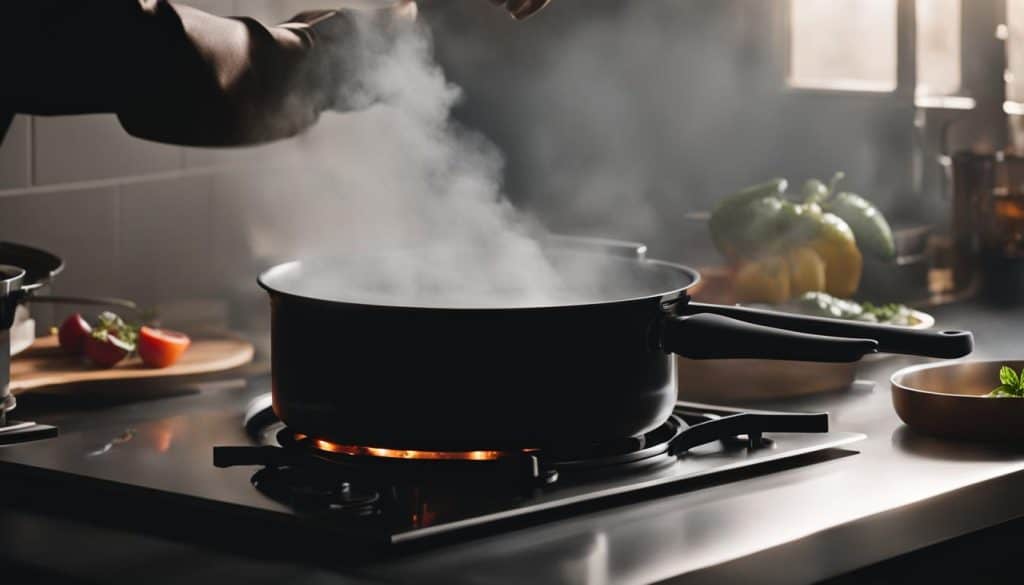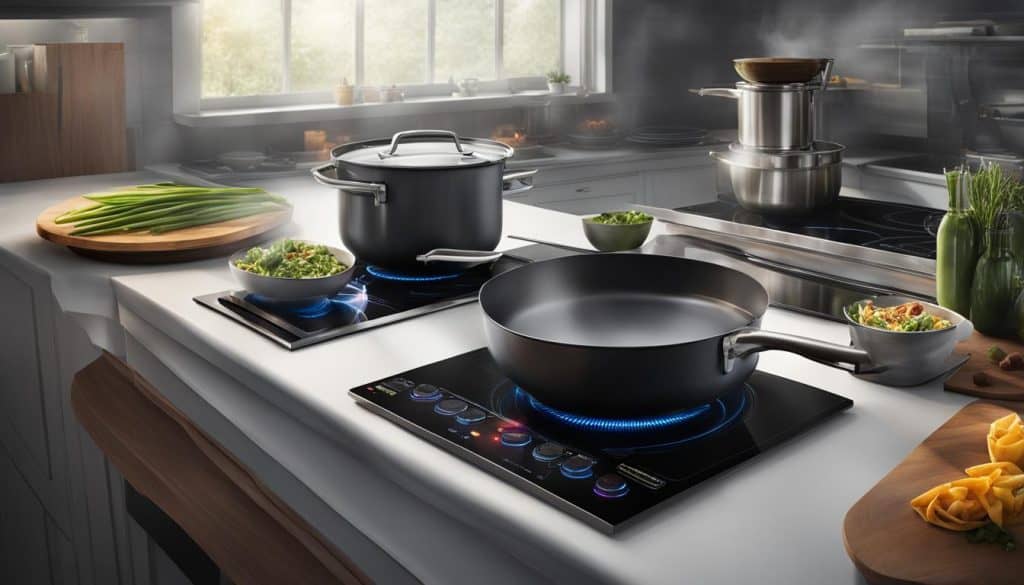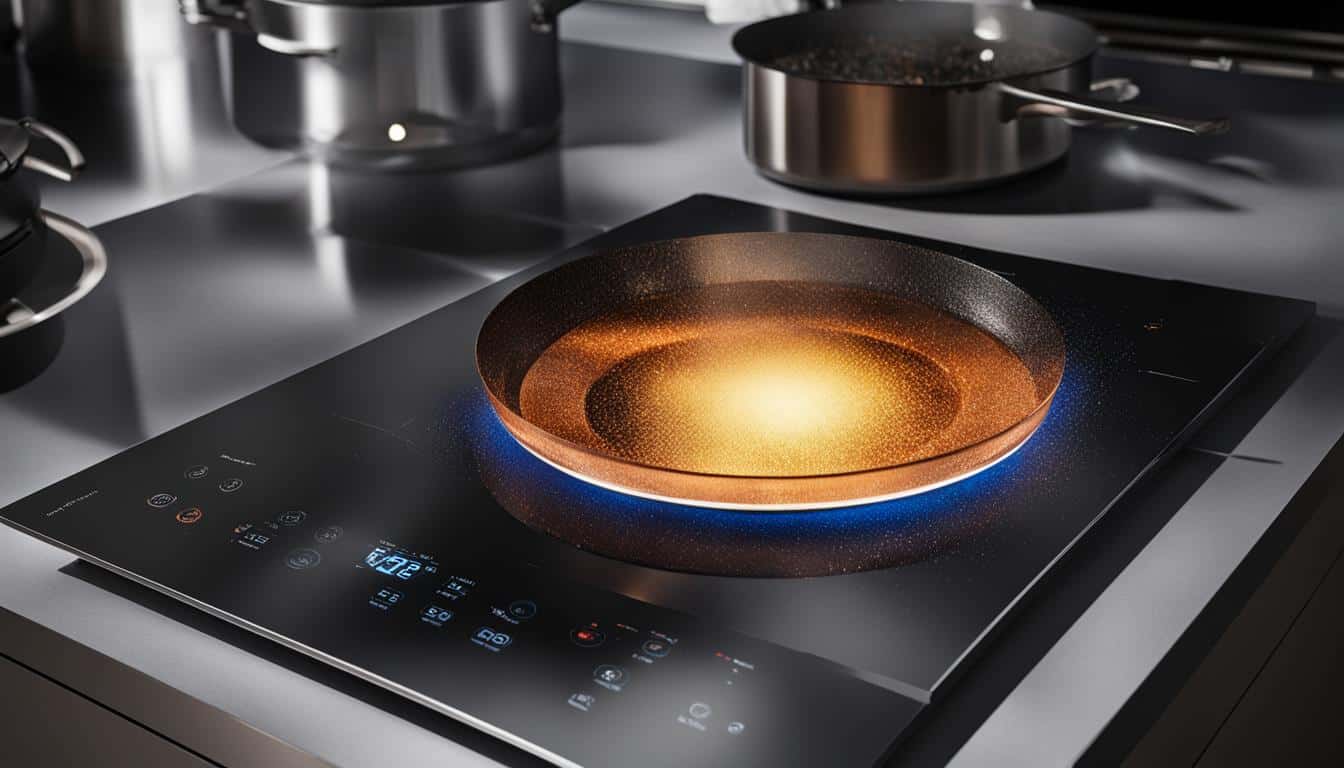Have you ever wondered about induction cooktops and all the stories you hear about them? Well, we’re going to explore these cool kitchen gadgets and see what’s really up!
First off, let me tell you, induction cooktops are like magic. Seriously, they cook food super fast, which is awesome when you’re really hungry and don’t want to wait forever for your pasta. But, some people worry about safety and health concerns.
I get it, the idea of cooking with electromagnetic fields sounds like something out of a sci-fi movie, but it’s actually pretty safe.
I remember the first time I used one, I was a bit nervous – I mean, what if I accidentally created a mini black hole in my kitchen, right? But it turns out, it’s not only safe but also super efficient. No mini black holes, I promise!
Another cool thing? They’re easy to clean. Imagine you’re experimenting with making the perfect chocolate syrup and oops! – a bit spills over. On a regular stove, that’s a sticky mess. But on an induction cooktop, it’s a quick wipe, and voilà, all clean!
Plus, they’re energy savers, which is great for keeping those electricity bills down. Just remember, you might need special cookware that works with the cooktop. No biggie, though, because who doesn’t love shopping for new kitchen stuff?
So, that’s the scoop on induction cooktops. They’re speedy, sleek, and make you feel like a cooking superhero. Don’t let the myths scare you; these cooktops might just be the truth you’re looking for in your kitchen adventures!
Myth 1: Induction cooktops only work with specific cookware.
Induction cooktops have long been associated with the myth that they only work with specific types of cookware. However, this is not entirely accurate.
Most modern cookware made of ferromagnetic materials such as stainless steel or cast iron can be used on induction cooktops. This includes cookware from popular brands like All-Clad, Cuisinart, and Le Creuset.
If you’re not sure whether your existing cookware is compatible with induction cooking, there’s a simple method to check. Place a magnet on the bottom of the pot or pan. If it sticks firmly, your cookware is compatible. If it doesn’t, you’ll need to invest in new cookware made of ferromagnetic materials.
There’s no need to worry about replacing your entire cookware collection. In fact, induction cooktops are a great excuse to upgrade your kitchen and invest in new cookware that will work seamlessly with your new appliance.
Myth 2: Induction cooktops are unsafe.
One of the most common misconceptions about induction cooktops is that they are unsafe compared to gas or electric stoves. This myth is often perpetuated by the assumption that induction cooktops get hotter and pose a greater risk of burns or accidents. However, this couldn’t be further from the truth.
“Induction cooktops are safer than both gas and electric stoves, with no open flames or hot surfaces.”
One of the primary reasons induction cooktops are considered safer than gas and electric stoves is that they have no open flames or hot surfaces. This feature eliminates the risk of accidental burns or fires caused by flammable materials coming into contact with the stove’s heating elements.
Induction cooktops are designed to heat pots and pans directly, without generating heat around the pot. This means that once the cookware is removed from the stove, the heating stops instantly. Thus, there is no residual heat left behind, which reduces the risk of accidental burns.
Another significant safety feature of induction cooktops is their automatic shut-off technology, which detects when a pot or pan is not on the cooktop surface and prevents the stove from heating up. This reduces the risk of accidents caused by leaving the stove on by mistake.
Overall, induction cooktops are much safer than gas and electric stoves, with fewer opportunities for accidents to occur. By removing open flames, hot surfaces, and residual heat, induction cooktops provide a much safer cooking experience that homeowners can enjoy without worrying about accidental burns or injuries.

Myth 3: Induction cooktops are expensive to operate.
There is a common misconception that induction cooktops are expensive to operate, but in reality, they are highly energy-efficient, making them a cost-effective option in the long run.
Induction cooktops use electromagnetic fields to directly heat the cookware, which means that no heat is wasted on the surrounding air, unlike gas and electric stoves. This direct heating method not only saves energy but also reduces cooking time, which means less time spent in the kitchen and lower energy bills.
Additionally, induction cooktops require minimal maintenance and repairs, which can add up to significant cost savings over time.
Cleaning an induction cooktop is easy since the surface is smooth and flat, unlike traditional stoves with burners and grates that can be challenging to clean. As a result, induction cooktops require less time, effort, and money spent on maintenance and repairs.
A study carried out by Energy.gov found that induction cooking is 84% efficient compared to gas at 40% and electric at 74%. While the initial cost of purchasing an induction cooktop may be higher than that of a conventional stove, the energy savings over time can significantly outweigh the costs.
The increased efficiency of induction cooktops can positively impact the environment by reducing overall energy consumption.
Comparative Cost Analysis of Induction vs. Gas Cooktops
| Induction Cooktop | Gas Cooktop | |
|---|---|---|
| Installation Cost | $800-$2,000 | $400-$1,000 |
| Energy Consumption Cost (per year) | $18.92 | $38.74 |
| Maintenance Cost (per year) | $0 | $20 |
| Total Cost Over 10 Years | $1,789 | $2,672 |
“While induction cooktops may have a higher initial cost, they can save you money in energy and maintenance costs over time. Plus, they are more energy-efficient and have a smaller environmental impact.”
Myth 4: Induction cooktops are difficult to clean.
Another misconception about induction cooktops is that they are difficult to clean. In reality, induction cooktops have a smooth surface that makes them easy to clean.
Unlike traditional stoves with grates and burners, induction cooktops have minimal surface variation, making it easy to wipe away spills and stains. The smooth surface also means that food particles are less likely to get stuck in hard-to-reach areas.
To clean your induction cooktop, simply wipe it down with a damp cloth or sponge and a mild cleaning solution. Avoid using abrasive cleaners or scrubbers that could damage the surface. For tougher stains, a mixture of baking soda and water can do the trick.
Overall, cleaning an induction cooktop is easier and less time-consuming than cleaning a traditional stove, making it a great choice for busy households.

Myth 5: Induction cooktops are slow to heat up
Another common myth surrounding induction cooktops is that they are slow to heat up. In reality, induction cooktops heat up significantly faster than traditional stoves, eliminating the need for preheating.
The reason for this is that induction cooktops heat the cookware directly, rather than transferring heat t ough the air like gas and electric stoves. This direct heat transfer results in faster cooking times and enhanced efficiency in the kitchen.

It’s a common misconception that because induction cooktops are so speedy, they may be less safe to use. However, due to the built-in safety features of induction cooktops, such as automatic shut off when there is no pan on the surface, they are just as safe as traditional stoves.
Myth 6: Induction Cooktops are Noisy
Another common myth about induction cooktops is that they are noisy. While older models may have been noisy, modern induction cooktops are designed to be quiet during use.
You may hear a faint hum from the cookware vibrating on the surface, but generally, induction cooktops are much quieter than traditional gas or electric stoves.
One reason why induction cooktops are quieter is that they lack open flames or heating elements, which produce noise. Instead, induction cooktops use electromagnetic currents to heat the cookware directly.
As a result, induction cooking creates less noise pollution in your home, allowing for a more enjoyable cooking experience.

Did you know that induction cooking is so quiet that you can have a conversation while cooking without raising your voice?
If noise is a concern for you, consider upgrading to a modern induction cooktop. You will enjoy the benefits of a quiet cooking experience and will not have to worry about disturbing others in your home.
Myth 8: Induction cooktops are susceptible to damage from magnetic fields.
Concerns around the vulnerability of induction cooktops to magnetic fields persist. Some believe that the strong magnetic fields used in induction cooking can harm electronic devices, such as credit cards and pacemakers. However, these fears are largely unfounded.
The magnetic field generated by an induction cooktop is confined to the cookware and is not strong enough to harm most electronic devices. In fact, the magnetic field strength of an induction cooktop is similar to that of a refrigerator magnet.
While it is advisable to keep credit cards and pacemakers away from the cooktop, they are unlikely to suffer any damage from the magnetic field.
It is worth noting that some older models of induction cooktops may produce more substantial electromagnetic interference than newer models. However, modern induction cooktops are designed to minimize electromagnetic interference and are safe for everyday use.

“This myth is one of the most persistent misconceptions about induction cooktops. In reality, the magnetic field generated by induction cooktops is not strong enough to harm electronic devices. As long as you take basic precautions, such as keeping credit cards and pacemakers away from the cooktop, you can enjoy the benefits of induction cooking without fear of damaging your electronics.”
Myth 8: Induction cooktops are susceptible to damage from magnetic fields.
One of the common concerns about induction cooktops is the susceptibility to damage from magnetic fields. However, it is a myth that induction cooktops can harm electronics, such as credit cards or pacemakers.
The magnetic field generated by induction cooktops is not powerful enough to damage most electronic devices. The electromagnetic interference produced by an induction cooktop is concentrated within a couple of inches above the surface, which is unlikely to cause any harm to electronic devices.
However, it is still essential to be cautious when using electronic devices near induction cooktops. Keeping items such as credit cards and pacemakers at a safe distance from the cooktop is recommended.

“The magnetic field generated by an induction cooktop is not strong enough to cause any harm to electronic devices.”
Myth 10: Induction Cooktops Are Difficult to Install
It’s a common myth that induction cooktops are difficult to install. However, I can assure you that they are just as easy to install as traditional electric stoves, often requiring the same electrical connections.
Easy installation: Induction cooktops are designed to be compact and easy to install. With just a few steps, you can have your new cooktop up and running in no time.
Electrical connections: As with most electric stoves, induction cooktops require an electrical connection to work. You will need to ensure that your kitchen has the proper electrical setup to support the cooktop.
While the installation process may seem daunting at first, it’s important to remember that safety always comes first. It’s crucial to consult a qualified electrician for installation to ensure that all connections are correct and that the cooktop is functioning properly.

“I was hesitant to install an induction cooktop in my kitchen because I thought it would be too difficult. However, with the help of a qualified electrician, the installation was a breeze. I’m so glad I made the switch!” – Jane D.
Don’t let the myth of difficult installation keep you from enjoying the benefits of an induction cooktop. With easy installation and the right professional help, you can elevate your cooking experience in no time.
Myth 10: Induction Cooktops are Not Worth the Investment
I can confidently say that induction cooktops are worth the investment. The benefits they offer far outweigh any potential drawbacks, making them an excellent addition to any kitchen.
Benefits
Induction cooktops provide numerous benefits, including speed, efficiency, safety, and ease of cleaning.
Speed and Efficiency
Induction cooktops are known for their exceptional speed and efficiency. They heat up quickly, reducing cooking times significantly. Additionally, they provide precise temperature control, making it easier to achieve perfect results every time you cook.
Safety
Induction cooktops are safe to use. They have no open flames or hot surfaces, reducing the risk of burns or accidents. Additionally, they automatically shut off when there is no pan on the surface, making them a safer option than traditional stovetops.
Cleaning
Induction cooktops are effortless to clean. They have a smooth, flat surface that makes wiping away spills and messes a breeze. Unlike traditional stovetops, there are no crevices or burners to clean, making induction cooktops a more hygienic option.
Enjoyable Cooking Experience
Investing in an induction cooktop can enhance your cooking experience by providing you with advanced features that make cooking more enjoyable. Induction cooktops have a sleek and modern design, making them an attractive addition to any kitchen. Additionally, their precise temperature control and quick heating times allow for more creativity and experimentation in the kitchen.


